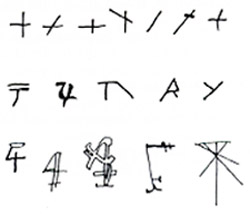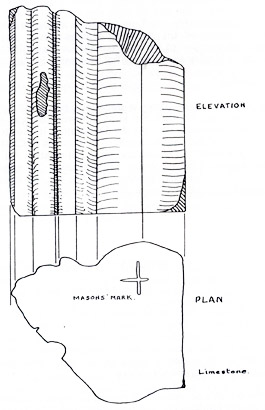Articles
Medieval Masons' Marks
by Cynthia Graham Kerr
A number of masons' marks were found among a heap of assorted Medieval masonry recently discovered in an old garden at Mapledurham. They were evidently a ‘job lot’, bought originally, perhaps, to make a rockery and then forgotten. Some of the stones had been carved as part of architectural features and some carried more than one mason's mark (Fig. 1). The owner was in the process of laying the stones to make garden paths around a sundial centrepiece; other stones were still lying buried in the shrubbery.

Fig.1: Masons' marks on a carved stone
SOAG obtained the owner's permission to record the stones before they were incorporated into the paths and the marks hidden. We had first consulted John Steane, Environmental Officer at Woodstock Museum, who visited Mapledurham and examined the stones with us. He encouraged our recording and contacted the owner on our behalf: we are grateful to both of them for enabling this project to take place.
The garden belongs to the old vicarage, opposite the church, but although we looked carefully at the present church stonework, it was not obviously related to the masonry fragments although they may have been dumped in the garden at some point during alterations in the past.
The stones
Nearly all the stone was oolitic limestone although there were, interestingly, several pieces of carved clunch which is used locally but usually only in sheltered locations as it weathers badly. Some pieces were of a red sandstone which does not occur naturally in the area. A few pieces had been burned or fire-reddened.
The stones include valuable examples of Medieval carving. Some of the more notable fragments included a scalloped capital still attached to the top of a column, a piece of column with a chevron pattern and a column fragment with ribbed decoration and a chevron design on it: these were all Norman. There were numerous fragments of door jambs and vertical pieces from window frames, and a piece of very ornamental cornice which perhaps came from a tomb. The fragments range in date from the 12th or possibly late 11th century, up to the 15th or early 16th century.
The marks
We have not been able to trace any references to masons' marks in the literature. All the different types found were recorded (Fig. 2). These appear to vary according to the skill (and perhaps seniority) of the mason: quite a number consist of just two or three simple lines gouged quickly with a tool. A figure resembling the number 4 seemed to be popular, with variations, and some were very elaborate with hidden meanings, no doubt, in every line. Initials occur, and also Roman numerals. Each man seems to have had his own mark as a personal trademark, to identify stones from the chisel of a particular mason: quality control was important in the Middle Ages. Other marks indicate where a stone was to be mortared onto an adjoining one (Fig. 3).

Fig.2: Marks recorded at Mapledurham

Fig.3: Architectural fragment with a mark on the base (max. diam. 220mm)
The pieces are not necessarily related to each other and may represent a collection of unwanted stones bought from a building or architectural firm, perhaps specialising in the restoration of ancient buildings. Or maybe a Victorian vicar took a fancy to them when so many local churches were being ‘modernised’. It is probable, although it cannot be established, that they came from church buildings in south Oxfordshire.
This article was first published in SOAG Bulletin No.48 (1992). The SOAG Bulletin is published yearly and is free to members.


